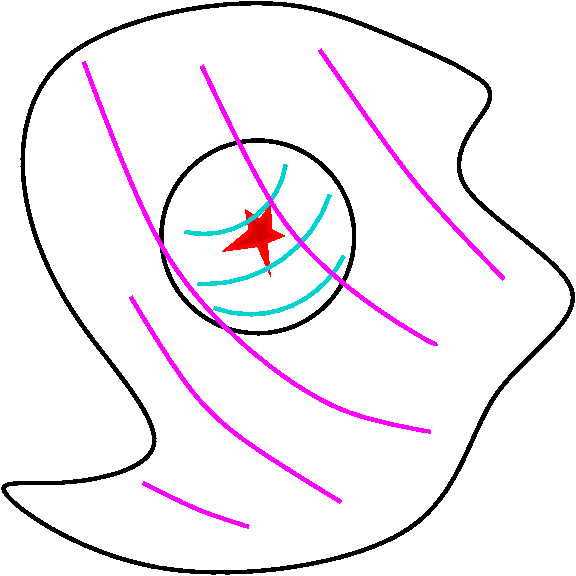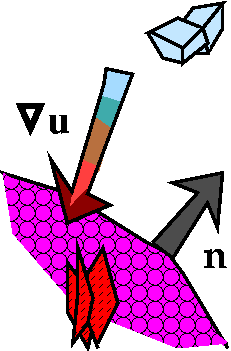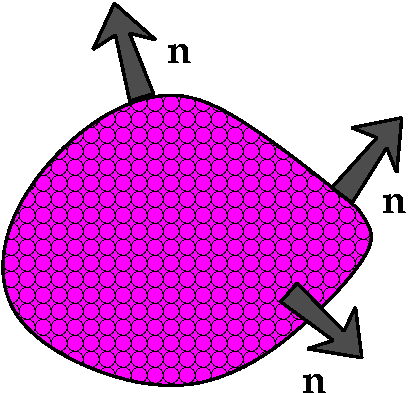Let's start with an inverse square force field in R3 centered at the origin:
F=-xi/(x2+y2+z2)3/2-yj/(x2+y2+z2)3/2-zk/(x2+y2+z2)3/2
I want the divergence of F so I probably need to compute things like this: (
The vector field, F(x,y,z), should be
P(x,y,z)i+Q(x,y,z)j+R(x,y,z)k and P, Q, and R
should be differentiable functions. The divergence of F is ![]() ·F: (
·F: (![]() P/
P/![]() x)+(
x)+(![]() Q/
Q/![]() y)+(
y)+(![]() R/
R/![]() z).
Gauss's Law [Not discussed in lecture.]
z).
Gauss's Law [Not discussed in lecture.]
Let's start with an inverse square force field in R3
centered at the origin:
F=-xi/(x2+y2+z2)3/2-yj/(x2+y2+z2)3/2-zk/(x2+y2+z2)3/2
I want the divergence of F so I probably need to compute things
like this: (![]() /
/![]() x)(-x/(x2+y2+z2)3/2)=I'm tired! I'll have a friend compute this:
x)(-x/(x2+y2+z2)3/2)=I'm tired! I'll have a friend compute this:
> A:=diff(-x/(x^2+y^2+z^2)^(3/2),x):
> B:=diff(-y/(x^2+y^2+z^2)^(3/2),y):
> C:=diff(-z/(x^2+y^2+z^2)^(3/2),z):
> A+B+C;
2 2 2
3 3 x 3 y 3 z
- ----- + ----- + ----- + -----
3/2 5/2 5/2 5/2
%1 %1 %1 %1
2 2 2
%1 := x + y + z
> simplify(A+B+C);
0
So the divergence of F is 0. But now let me compute the flux of
F across a sphere of radius A centered at the origin:
x2+y2+z2=A2. We can get a
normal to this sphere by taking the gradient:
2xi+2yj+2zk. A unit normal pointing "out" is
n=(x/A)i+(y/A)j+(z/A)k. Then F·n is
 Confusion!
Confusion!
But the divergence is 0 and the flux should be the integral of the
divergence, so ... what's going on? Again (we saw this earlier in an example with Green's Theorem) the vector field
F is not differentiable in all of the inside of the sphere: it
is not even defined at the origin. Here we have the flux equal to a
(non-zero) constant, not depending on the radius of the sphere.
Take any surface which completely surrounds the origin. Put a sphere centered at the origin with very small radius between that surface and the charge at the origin. The Divergence Theorem applies to the region between the sphere and the origin since F is differentiable away from the origin. But div F is 0 in that region, so the total flux integral must be 0. That means the flux integral outward through the surface is exactly balanced by the flux integral inward through the sphere. The flux integral through the sphere does not depend on the radius of the sphere, so the surface flux doesn't depend on anything except that the surface does wrap completely around the origin. And this is (a version of) Gauss's Law: the flux integral around an isolated point charge is always constant.
Gauss's Law is discussed in many physics books. Also you can look at pages 1130 and 1131 of the textbook. Again, my apologies for messing this up in lecture!
Deriving the Heat Equation using the Divergence Theorem
I mostly followed the presentation here.
The heat equation governs a vast variety of propagation phenomena. I
know it is used to describe how heat distributes itself. It also is
used to analyze diffusion phenomena, such as salt in a solution of
water. It can be used, one colleague assures me, to study the
migration of moose. And how gossip spreads through a population. And
certain kinds of epidemics. And in finance, the heat equation applies
to analyze the flow (!) of money. The heat equation depends on two
fundamental assumptions. If "your" problem also can be translated so
it satisfies these two fundamental assumptions, then you also need the
heat equation. The names attached to what I'll describe here include
Newton, Euler, and Fourier.
We will deal with a homogeneous, isotropic material. Here "homogeneous" means the material is the same from one point to the next, and "isotropic" means that the directions around a point all have similar properties. Bean soup is not homogeneous because of the beans and the soup. A piece of lumber is not isotropic because behavior with/against the grain is different.
Assumption #1
The heat inside a small piece of material is directly proportional to
the mass of the material and the temperature. The constant of
proportionality is called specific heat. Using the language of
Math 251, we can write that the heat inside a small piece of
material=![]()
![]()
![]() The pieceK(Density)u(x,y,z,t) dV.
Here K is the specific heat, and Density is the density of the
material (so Density dV is a small amount of mass). Density and K
are constants in our circumstances. u(x,y,z,t) is the temperature at
the point (x,y,z) of the material at time t. In class, and in the reference cited
above some specific heats are discussed (water has high K and
metals, lower).
The pieceK(Density)u(x,y,z,t) dV.
Here K is the specific heat, and Density is the density of the
material (so Density dV is a small amount of mass). Density and K
are constants in our circumstances. u(x,y,z,t) is the temperature at
the point (x,y,z) of the material at time t. In class, and in the reference cited
above some specific heats are discussed (water has high K and
metals, lower).
Assumption #2
Heat flows from hot to cold. The heat flow is directly proportional to
both the difference in temperature and to the cross-sectional area
through which the heat flows. If there is a big surface through which
the heat can flow, than there will be much more heat flow. And if the
temperature difference is high, there will be more heat flow. The
constant of proportionality here is called the conductivity,
c. Again, we discussed these assumptions in class and the reference
has further information. I can stir a hot stew safely with a wooden
spoon (relatively low conductivity) but I'd better be careful if I use
a spoon made of metal (higher conductivity).

Hot inside
But I need to be careful. Consider a small part of the surface of our
small piece. Suppose, for example, that the inside of the piece is
warmer than the outside. The gradient of the
temperature, ![]() u, points in the
direction of increasing temperature. So it will point towards the
inside of the piece. If we compare an outward-pointing unit normal,
then
u, points in the
direction of increasing temperature. So it will point towards the
inside of the piece. If we compare an outward-pointing unit normal,
then ![]() u·n will be negative because the
angle between the two vectors is between Pi/2 and Pi and cosine is
negative in that range. So if the inside is hotter,
u·n will be negative because the
angle between the two vectors is between Pi/2 and Pi and cosine is
negative in that range. So if the inside is hotter,
![]() u·n is negative.
u·n is negative.
 Hot outside
If the temperature is hotter outside, then the gradient vector of the
temperatur will point outwards, towards the higher temperature. Then
if we compute
Hot outside
If the temperature is hotter outside, then the gradient vector of the
temperatur will point outwards, towards the higher temperature. Then
if we compute ![]() u·n the result will positive
because the angle between the two vectors is between 0 and Pi/2. So
the "contribution" of the dot product is positive if the outside is
hotter than the inside.
u·n the result will positive
because the angle between the two vectors is between 0 and Pi/2. So
the "contribution" of the dot product is positive if the outside is
hotter than the inside.
So the dot product ![]() u·n is positive when the heat flows
towards the piece and negative if the heat should flow away.
u·n is positive when the heat flows
towards the piece and negative if the heat should flow away.
Art! By the
way, the pictures are supposed to show hot with flames and cold with
ice cubes. This is tremendously imaginative and wonderful. maybe

Therefore the amount of heat coming in/going out is ![]()
![]() The surface of the piecec
The surface of the piecec![]() u·ndS.
u·ndS.
But the change in the heat over time is also (![]() /
/![]() t)
t)![]()
![]()
![]() The pieceK(Density)u(x,y,z,t) dV.
This is one place where our simplifying assumptions help a great
deal: K and the Density are constant. Only u varies with time. So
this is equal to
The pieceK(Density)u(x,y,z,t) dV.
This is one place where our simplifying assumptions help a great
deal: K and the Density are constant. Only u varies with time. So
this is equal to
![]()
![]()
![]() The pieceK(Density)(
The pieceK(Density)(![]() u/
u/![]() t) dV.
t) dV.
Now comes the magic! We apply the Divergence
Theorem to the surface integral giving the change in heat and get
![]()
![]()
![]() The piecedivergence of c
The piecedivergence of c![]() u dV.
u dV.
Well, c![]() u is
cuxi+cuyj+cuzk
and the divergence of this (c is a constant) is
c(uxx+uyy+uzz). By the way, the
collection of derivatives uxx+uyy+uzz
also has a specific name: it is called the Laplacian. Notation
for the Laplacian of u varies. In some places,
u is
cuxi+cuyj+cuzk
and the divergence of this (c is a constant) is
c(uxx+uyy+uzz). By the way, the
collection of derivatives uxx+uyy+uzz
also has a specific name: it is called the Laplacian. Notation
for the Laplacian of u varies. In some places, ![]() 2u is used, and, otherwise,
2u is used, and, otherwise,
![]() u is used.
u is used.
And so:
We now know that for any little piece of the material, the following
triple integrals are equal because they both give the change in heat
of the little piece:
![]()
![]()
![]() The pieceK(Density)(
The pieceK(Density)(![]() u/
u/![]() t) dV=
t) dV=![]()
![]()
![]() The piecec(uxx+uyy+uzz) dV.
If we take a really really tiny piece, then the functions inside each
integral are approximately constant (because they are continuous!) so
we can approximate the integrals by the function values and the
volume:
The piecec(uxx+uyy+uzz) dV.
If we take a really really tiny piece, then the functions inside each
integral are approximately constant (because they are continuous!) so
we can approximate the integrals by the function values and the
volume:
K(Density)(![]() u/
u/![]() t)The Volume=c(uxx+uyy+uzz)The Volume
t)The Volume=c(uxx+uyy+uzz)The Volume
Divide both sides by The Volume and get The Heat Equation:
K(Density)(![]() u/
u/![]() t)=c(uxx+uyy+uzz)
t)=c(uxx+uyy+uzz)
Then we can "study" this equation: try to find approximate solutions
or to study qualitative aspects of solutions, or ... well, I will
admit it: only very rarely can exact solutions which are physically
interesting be found. It turns out that the heat equation and its
"solutions" are good models of many physical situations.